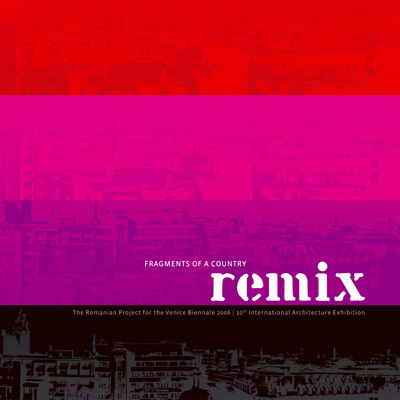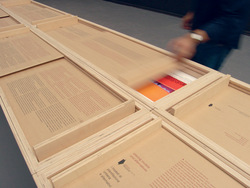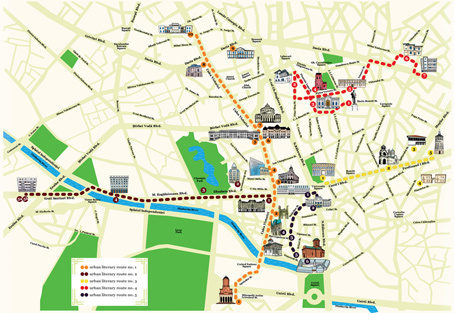URME (in Romanian language means footprints, tracks) proposes the reactivation of the urban memory of seven European cities, through multidisciplinary studies that re-create the cultural atmosphere at different moments in their historical development. Using contemporary methods, URME intends to signalize urban sites as part of the literary and cultural history of the city.
News
Remix awarded at the Bucharest Architecture Annual
Remix Catalogue / fragments of a country was awarded in the “arhitecture book” section at the Bucharest Architecture Annual Exibition 2007. The catalogue was coordinated by Stefan Ghenciulescu, Constantin Goagea, Cosmina Goagea, Ana Bleahu.The catalogue will be reeditated with the occasion of the opening of Remix project at Dalles Hall, Bucharest, 7th of June.

Fragments, energies, involvement
During the totalitarian period, in Romania there was only a team of 22 million players forced to play against it self. The team had an absolute leader, arbitrary rules and individual surviving and resistance strategies.
Now, 17 years since the brutal collapse of the regime, it seems that there are 22 million teams, each playing by its own rules. The game runs out of control, and we witness a fascinating, yet worrying collision of various energies. A prison-like territory has not changed into one of negotiations, but in a no man’s land patched with an infinity of private and closed spaces. Urbanity has become a disjointed archipelago of places.
How can all these energies coagulate to create a community spirit again? Will it happen before the remains of the natural and built heritage disappear and chances of a balanced development fade away?
Maybe this chaos is normal for a breakthrough after such a long period of total authority. There’s no question to regret the totalitarian control; but it seems we still have to learn to coagulate all these energies into a community spirit and a real public project concerning a the territory. Limitation or emphasizing, channeling and negociation could replace both ineffective control and lack of care.
The exhibition
assumes the fragmentary character of Romanian reality. It encapsulates out of the infinity of personal fragments nine fundamental categories, thus describing territorial “myths”: Energies and potentials, public space, dwelling models (the dream houses), social segregation (gentrification opposed to extreme poverty), environmental problems, landmarks and the heritage, towns, the village and, finally, planning. The exhibition also shows how alternative approaches like democratic planning, responsible architecture and social projects try to counterbalance the global mechanisms. The catalogue – an interdisciplinary research by architects, planners, sociologists, a geographer etc. develops the themes of the exhibition and is meant to represent a publication on its own.
A game with pieces of territorial identity
Its pieces are represented by the nine categories of the exhibition. The game consists in remixing the given collection of fragments: the player will compose his own image about the future urban development in Romania. Finally, the sum of these individual games renders the image of a shared project, a model of how to shape future urban identity in Romania; or, rather, it will show the main unbalanced areas, the ones that mostly need negotiation and community involvement. A game that models active participation and responsibility.
The idea governing this game is the presumption that, in order to undertake a responsibility, the first step is to state your personal opinions on a general evolution, all that, beyond your personal and immediate interests. The game gives a shape to this first step. This should be followed by a dialogue between the different positions and then by negotiation and by an accepted evolution.
How does the game take place?
The nine categories, transformed in symbolic questions, take the shape of polyurethane cubes, covered in a textile material. The question is written on two of the opposite sides, and the four possible answers on the other four. The player shall have to arrange each of these cubes on a table in a new schedule of squares, with the side containing their preferred answer up. Each side contains a hidden identification plate. For each cube put into place, an electronic system will “read” the answer and it will transmit it to a computer, which has the decrypting program installed. It interprets the answers and displays them on a screen. As soon as a cube is put on the game table, a real image from Romania appears on the screen, one that is representative for the choice. Once the nine cubes are put into place, the final result, the interpretation of the choice will be displayed. The player will therefore find out what kind of development they actually chose, how modern or how conservative, how liberal or how much aware of its ecological problems would be the Romania they remixed. The result displayed on the screen will be then printed on a cardboard, a player “diploma”.
Decrypting, involvement, responsibility
The game was not only conceived as a simple art installation, but also as a sociologic instrument. There have therefore been drafted dimensions for analysis, in the form of a group of 3 dichotomous variables, namely: modernity-traditionalism, individuality- collectivity, ecologic orientation – development.
The dichotomous variables represent in fact a synthetic index composed of 9 items whereby certain statistic connections are defined. The nine items are expressed in the nine cubes (questions). An item comprised 4 distinct identities (the elements of the game – the 4 possible answers). In order to reach a quantitative assessment of the dichotomous variables it is necessary to quantify the elements composing the items. For each of the 6 dimensions, each element receives a number of points from 0 to 4, where 0 stands for the lack, the nonexistence of the phenomenon and 4 stands for the maximum existence (from a statistic point of view) of the relevant choice. In other words, choosing, for example the element “rural household” for the item “ideal home”, the points given for the dimensions of traditionalism and individuality shall be maximum.
Applying this type of scale shall lead to obtaining a set of values that are fit for mathematical models with the purpose of an analysis on the relation between the phenomena.
During the drafting of the project, the game and the significance given to its elements have evolved from a symbolic molding of the involvement to the additional dimension of quantitative instrument, structured to poll certain social phenomena such as the management of the public space, assuming civil responsibility, involvement in the decision-making process. A significant sum of games, corroborated with a mapping of the players’ data (age, social category etc.) could show the image a group has on its territory.
The game has been played both in Bucharest, and within the Romanian pavilion in Venice. It will be played again in Bucharest, and, hopefully, developed and enhanced. The playing in Venice is maybe sociologically less relevant, but even more so as an installation: it invites to an involvement into a space of otherness. It is therefore suggested the idea that, especially in our days, we must also get bothered with respect to places which apparently we are not directly related to. The problems of the urban world of today claim far more than a mere technical expert assessment and exchange of experience: we need global solidarity and involvement.
Design
The design data were three major elements – the exhibition, the game, the information and control centre, a long and narrow space accessed transversally and a very tight budget. We chose to place the exhibition not on the walls, but in 10 boxes (corresponding to the nine sections and to an introduction) placed on the longitudinal axis. One doesn’t find all the informations directly, but has to dig through layers: on the top are the writings, beneath them pictures and legends. The desk, the platform for the game, the bench for the cubes and the screen align naturally along the same axis. The freed walls are occupied only by instructions for the game, a short presentation of the concept and a series of stencils that symbolically and jokefully represent the sections of the exhibition. The materials are simple and cheap: laminated wood sheets for the boxes, the desk and the game kit, painted strips on the wall, a rubber floor in the game zone and industrial paint on the rest of the floor. We tried to create a playful yet serene atmosphere with the most simple means.
romanian press:
http://www.evz.ro/article.php?artid=267080
http://antena3.ro/index.php?left_choose=clt&id=16831&ext=1
http://www.gandul.info/2006-08-01/arte/realitatea_urbana
http://www.romanialibera.ro/editie/NEW_SITE/index.php?a=1&fct=1&complet=1&idx=6&tab=z26012006
http://www.antena3.ro/index.php?search=on&arc=on&id=16831&text=cuburi
http://www.infoportal.ro/articol~din-cultura~info-16905~dreamville-romanesc-la-venetia-in-2007~cauta-dreamville~perioada-toata_arhiva.html
http://www.infoportal.ro/articol~din-cultura~info-16821~dreamville-proiectul-care-va-reprezenta-romania-la-venetia-asemanator~cauta-dreamville~perioada-toata_arhiva.html
http://www.infoportal.ro/articol~din-cultura~info-16771~romania-merge-cu-orasul-visurilor-la-bienala-de-la-venetia~cauta-dreamville~perioada-toata_arhiva.html
http://www.azi.ro/arhive/2006/01/27/daca.htm
http://www.gandul.info/articol_5893/dreamville__proiectul_care_va_reprezenta_romania_la_venetia___asemanator_cu_un_joc_virtual_disponibil_pe_internet.html
http://www.gandul.info/articol_12138/realitatea_urbana___noua_cuburi_si_o_multime_de_creiere.html
http://www.evz.ro/article.php?artid=267080
http://cultural.srr.ro/arhiva/arhiva3.shtml?env.newst_date=2006-09-11
http://cultural.srr.ro/arhiva/arhiva3.shtml?env.newst_date=2006-01-26
http://www.revista-tomis.ro/ (februarie 2006)
http://www.romaniaitalia.net/content/view/999/2/
http://www.ziua.ro/display.php?data=2006-09-08&id=206832&kword=goagea+venetia
http://www.ziua.ro/display.php?data=2006-02-25&id=194517&kword=venetia+goagea
http://www.ziua.ro/display.php?data=2006-01-26&id=192446&kword=bienala+de+la+venetia
http://www.ziua.ro/display.php?data=2006-09-08&id=206832&kword=bienala+de+la+venetia
http://stiri.rol.ro/stiri/2006/01/dreamville_romanesc_la_venetia_in_2007.htm
http://www.artline.ro/module.php?module=newsannounce&category_id=584&item_id=8512&l=1&pag=8
http://www.gardianul.ro/2006/05/06/media_cultura-c20/ministerul_culturii_va_da_200_000_ron_pentru_pavilionul_romaniei_la_bienala_de_la_venetia-s78541.html
http://www.anuntgratis.ro/articole/index.php?newsid=4149&newscategoryid=5&search=&act=&page=1
http://www.gardianul.ro/2006/07/21/media_cultura-c20/reparatiile_la_pavilionul_romaniei_intarziate_din_lipsa_de_fonduri-s81904.html
http://www.supliment.polirom.ro/index.aspx?item=88
http://www.roportal.ro/stiri/stirea-386859.htm
http://www.opensubscriber.com/message/nettime-ro@nettime.org/4621201.html
http://www.bicau.ro/index.php?si=20&gr=12&st=969
http://www.ziare.com/?ziare=details&a_id=30417
http://www.cultura.ro/News.aspx?ID=710
http://stiri3.rol.ro/detaliere.php?id=353684
http://www.roportal.ro/stiri/stirea-439859.htm
http://cotidianul.ro/index.php?id=7029&art=17674&cHash=af3d922736
http://www.cotidianul.ro/index.php?id=7029&art=17674&diraut=42&cHash=12f0b79f08
http://stiri.zoot.ro/romania-remixata-la-venetia,145846.html
http://www.9am.ro/revistapresei/Cultura/38898/Proiectul-Romaniei-la-Bienala-de-la-Venetia-prezentat-si-la-Bucuresti
http://www.zzum.ro/arhivaromanialibera/2006-01-27/Romania-merge-cu-Orasul-Visurilor-la-Bienala-de-la-Venetia-.shtml
http://www.ziare.ro/articol.php/1154409896
http://www.onlinenews.ro/detaliere.php?id=353684
http://ziua.net/prt.php?id=192446&data=2006-01-26
http://my.ziare.com/?ziare=print&z_id=28789
http://www.phg.ro/stiri/Cultura/Regia_Autonoma_RomaniaFilm_va_fi_transformata_in_societate_comerciala-s45623.html
http://www.cronicaromana.ro/romania-la-bienala-de-la-venetia.html
http://stiri.orasultau.ro/index.php/pg/stiri_unu/id/44109.html
http://revistapresei.rol.ro/stiri/2006/02/romania_la_bienala_de_la_venetia.htm
http://www.jurnalul.ro/articol_45043/afla_ce_e_nou.html
http://www.observatorcultural.ro/informatiiarticol.phtml?xid=16159&print=true
http://www.observatorcultural.ro/informatiiarticol.phtml?xid=15964&print=true
http://www.business.ro/detaliere.php?id=376247
http://www.business.ro/detaliere.php?id=263786
http://stiri24.ro/article.php?id=227512
http://www.9am.ro/arhiva.php/2006/Iulie/Cultura/pagina_13
http://www.deconstruct.ro/aptudeit32.html
http://www.dilemaveche.ro/index.php?nr=143&cmd=articol&id=4149
http://www.presaromana.ro/ar/Romania-REMIXata-la-Venetia-6b7d782f2240d50c.html
http://www.dilemaveche.ro/index.php?cmd=articol&nr=&id=4148
http://www.dilemaveche.ro/index.php?cmd=hartasite&nr=143&titlu=BIENALA%20DE%20LA%20VENE%C5%A2IA
http://www.arhitectura1906.ro/revista.php?id=166&limba_noua=en
http://www.aol.ro/2006/octombrie/netologie.htm
international press:
http://epiteszforum.hu/?q=node/3369
http://www.archiportale.com/progetti/schedaprogetto.asp?origine=&IdProg=1602
http://www.labiennale.org/62/65144.pdf
http://www.labiennale.org/62/64448.pdf
http://www.baunetz.de/sixcms_4/sixcms/detail.php?object_id=20&area_id=2794&id=173307
http://www.arkitera.com/eventfile.php?action=displayEventFile&ID=27&year=&aID=267
http://www.licht-und-architektur.de/sixcms_4/sixcms/detail.php?object_id=20&area_id=2794&id=173307
http://my.opera.com/mildz/blog/show.dml/268238
http://www.arqchile.cl/xbienal_venecia.htm
http://www.archimagazine.com/abiennadieci.htm
http://www.architektor.ru/news_view.html?36
http://www.arquitecturahoy.com/
http://mobile.exibart.com/evento.asp?idevento=33151
radio, tv
Radio Romania Muzical – Stiri culturale – realizator A. Sarbu (interviu cu Cosmina Goagea si Stefan Ghenciulescu in studio, Constantin Goagea prin telefon) 22.08.2006
Radio Romania Actualitati – realizator Simona Roth (interviu cu Ana Bleahu in studio, Constantin Goagea, Stefan Ghenciulescu, prof. Arbore prin telefon) 16.09.2006
Radio Romania Actualitati – realizator Simona Roth (interviu cu Cosmina Goagea, Justin Baroncea) 10.11.2006
TVR 1 – reportaj Bienala de la Venetia
TVR Cultural / emisiuni: Frontierele privirii, Simetrii – realizator G. Boisnard
TVR Cultural – Jurnal cultural
TVR International
Tel. Torino – Italia – reportaj Bienala de la Venetia 10 septembrie 2006
Radio France International – interviu cu Stefan Ghenciulescu / 10.09.2006
Antena 1



